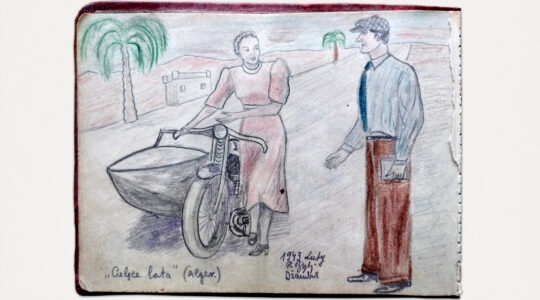It’s been said that sports doesn’t build character, it reveals it.
Pittsburgh’s WTAE-TV reported (Feb. 2) how a city celebrates a Super Bowl.
There were more than 100 arrests; drunk driving and bonfires; an overturned car and a cart that hit a man; a couch was set on fire in the middle of a street; trees were set on fire; bottles were thrown through windows.
Who needs a championship? The Chicago Tribune (Jan. 26) tells us that “a spate of violence” by high school students has prompted the city to decree that “fans of visiting teams will not be allowed inside gyms.” When two schools have a history of trouble, not even the home fans will be allowed in the gyms.
The more thuggish
the sports world, the more unusual and therefore newsworthy is the yeshiva world.
The St. Louis Post-Dispatch (Jan. 13) examined the Block Yeshiva team that plays against urban and rural schools in the Missouri State High School Association.
“Surprisingly, it is not the yarmulkes the boys wear. Or the skirts that some of the girls wear…. What really stands out is something that can’t be seen,” wrote the reporter.
A senior guard for an opposing team figured out the intangible: “They were extremely nice. I mean the whole team was nice — before and after the game.”
Here in New York, a story that didn’t make the papers nevertheless underlined how “extremely nice” these kids can be. At SAR High School’s recent David Cooper Memorial Tournament, the Riverdale school hosted girls’ yeshivas from Toronto, Memphis, Houston, Kansas City and Philadelphia. The visitors, far from home, had almost no fans at the games.
And then the stands were full and loud for the visitors. Several grades in SAR’s elementary school each adopted a visiting high school, dressing in their colors, waving signs and banners. One of the visiting coaches said, “Where did you get kids like these?”
The Toledo Blade (Jan. 11) did a story about the University of Toledo’s Naama Shafir, the first female Orthodox Jew to earn an NCAA Division I scholarship.
She’s Toledo’s leading scorer, and the Blade is paying attention. Her coach told the Blade, “It would be easy for [Naama] to say, I’m away from home, I’ll eat whatever, I’ll practice over Shabbat…. My team admires what she’s doing. She’s a great example of someone who is sticking to [her] guns and doing what [she] believes.”
Public radio has done a feature on Orange, Connecticut’s Beth Chana Skirts who play a non-yeshiva schedule.
ESPN’s Paul Lukas (who also runs the terrific UniWatch blog) has taken notice of the Stern College Lady Macs, and their modest on-court attire. As for Beth Chana, Lukas writes, “not only do they wear skirts (sometimes floor-length, sometimes knee-length with leggings or pants), but the team is actually called the Skirts — an admirably literal uni-based nickname that’s more accurate than, say, White Sox,” who wear black socks.
Lukas adds, “One of the Skirts has jazzed up her look with striped socks. She looks like she knows how to handle the ball and even has more star presence than the other gals when walking off the court.”
In his ESPN.com column (Jan. 28), Lukas examines how religious schools balance modesty and sports.
(Readers are invited to see Lukas’ photos of the Lady Macs and the Skirts on my blog, “Route 17,” on The Jewish Week web site. I’ve also posted the standings for New York’s yeshiva league, boys and girls, varsity and junior.)
Yes, yeshiva teams are nicer than most, but what about Orthodox teens off the court?
New Census Bureau data reveals that upstate’s Kiryas Joel, an all-Satmar village (pop. 21,000), is the poorest community in the entire United States.
Support the New York Jewish Week
Our nonprofit newsroom depends on readers like you. Make a donation now to support independent Jewish journalism in New York.
And yet, there is essentially no crime in Kiryas Joel, beyond some broken windows and an occasional punch in the nose.
For decades we’ve been told by hundreds of editorials that poverty breeds crime, even terrorism. Why not KJ? Where are the front-page stories seeking to comprehend the phenomenon? Also, KJ’s median age is 17, the worst possible demographic for crime.
Perhaps not the blame but the credit goes to KJ’s Satmar culture. They are called “extremists.” They have extremely low crime, defying the social scientists because they won’t defy the omnipresent God.
There was a German movie, some years ago, “Wings of Desire,” directed by Wim Wenders, taking place in the ruins of post-war Berlin. The movie imagines angels moving through the rubble, seeking moments of grace, reasons to believe in humanity. One angel hears through the walls, “Bereshit bara Elokim…,” untranslated, and the angel notes the lone voice. Other angels discover kindness, gentility, decency, not unlike reporters for the Post-Dispatch, or the Blade, or ESPN, wanting to report that there was something special, something “extremely nice.”
They say you can find God in a house of worship, or in the Grand Canyon at sundown. Now reporters note that God can be found with yeshiva kids in sneakers, and in the back alleys of the poorest place in America where no one has much and no one needs more.
jonathan@jewishweek.org
The New York Jewish Week brings you the stories behind the headlines, keeping you connected to Jewish life in New York. Help sustain the reporting you trust by donating today.




